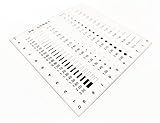Best Tools for Chart.js Integration to Buy in October 2025
To insert PHP array values into a Chart.js line chart, you can follow these steps:
- Start by creating a PHP array with the desired data that you want to display on the chart. This array should typically contain both labels and values for the chart.
- Initialize a JavaScript variable, e.g., chartData, to store the array values you retrieved from PHP. You can make use of PHP's json_encode() function to convert the PHP array into a JSON-encoded string, which can be easily accessed by JavaScript.
- Create an HTML canvas element using the tag within your HTML markup. The canvas element will serve as the container for your line chart.
- In your JavaScript code, instantiate a new Chart object, passing in the canvas element as the first argument. For example, var myChart = new Chart(canvasElement, { ... });.
- Inside the data property of the Chart configuration object, define an array for labels and a dataset array for datasets. The labels array should contain the labels for each data point on the x-axis, while the datasets array will store the data to be plotted on the y-axis.
- Assign the JSON-encoded PHP array data to the labels and data properties of the respective datasets object. The labels property should be assigned the array of labels obtained from PHP. For example, labels: . The data property should be assigned the array of values obtained from PHP. For example, data: .
- Specify other chart options and styling properties based on your requirements, such as chart type (type: 'line'), chart colors, tooltips, axes labels, and more.
- Finally, call the update() method on the chart object to render the chart and display the data.
With these steps, you should be able to insert PHP array values into a Chart.js line chart and visualize your data accordingly.
What are the necessary steps to display PHP array values in a line chart using Chart.js?
To display PHP array values in a line chart using Chart.js, follow these steps:
- Include the Chart.js library in your HTML file. You can download it from the Chart.js website or use a CDN link.
- Create a canvas element in your HTML file where the chart will be displayed.
- Create a PHP array with the data you want to display in the chart. For example:
$chartData = array(10, 20, 30, 40, 50);
- Convert the PHP array into a JSON string using the json_encode() function.
$chartDataJson = json_encode($chartData);
- Initialize a JavaScript variable and assign the JSON string to it.
- Write JavaScript code to create the line chart using Chart.js. Place this code in a
This code creates a line chart using the data from the PHP array. You can customize the appearance of the chart by modifying the options in the Chart() constructor.
What are the available animation options for displaying PHP array values in Chart.js line chart?
There are several animation options available for displaying PHP array values in Chart.js line chart. Some of these options are:
- Duration: It specifies the duration of the animation in milliseconds. You can set it using the animation.duration property.
- Easing: You can set the easing function for the animation using the animation.easing property. The available easing functions are linear, easeInQuad, easeOutQuad, easeInOutQuad, and many more.
- Animation Start: You can specify when the animation should start using the animation.animateScale and animation.animateRotate properties. These properties allow you to control the animation of scaling and rotating elements.
- Delay: You can add a delay before the animation starts using the animation.delay property. It specifies the delay in milliseconds.
- Looping: You can make the animation loop continuously using the animation.loop property. Set it to true to enable looping.
- Callbacks: Chart.js provides various callback functions that you can use to customize the animation behavior. For example, you can use the animation.onProgress callback to run a function during the animation progress.
These are just a few of the available animation options in Chart.js. You can refer to the Chart.js documentation for a comprehensive list and further customization options.
How to create multiple line charts using different PHP arrays in Chart.js?
To create multiple line charts using different PHP arrays in Chart.js, you can follow the steps outlined below:
Step 1: Prepare the HTML structure Start by creating an HTML file and include the necessary Chart.js library.
Step 2: Create PHP arrays Now, define multiple PHP arrays with your data. Each array will represent a separate line chart.
Step 3: Convert PHP arrays to JavaScript variables Next, convert the PHP arrays into JavaScript variables using json_encode().
Step 4: Render the line charts Finally, use JavaScript to render the line charts using Chart.js.
This code will create a line chart with three data lines using different PHP arrays. Customize the chart labels, colors, and other options as needed.
How to customize the appearance of a line chart created with PHP array values in Chart.js?
To customize the appearance of a line chart created with PHP array values in Chart.js, you can use the various configuration options provided by the library. Here are some steps you can follow:
- Include the Chart.js library in your HTML file:
- Create a canvas element to display the chart:
- Create a PHP array with the data you want to display: $data = [10, 20, 30, 40, 50];
- Convert the PHP array to a JSON string: $data_json = json_encode($data);
- Initialize the Chart.js chart with the PHP data: In the above code, you can customize the appearance of the line chart by modifying various options like lineTension to control the smoothness of the line, backgroundColor and borderColor to set the colors, borderWidth to set the border width, pointRadius to set the radius of the points, etc.
- Add any additional customization options in the options object to further customize the appearance of the chart. For example, you can modify the axis labels, title, legend, tooltips, etc. Refer to the Chart.js documentation for more customization options.
By following these steps, you can customize the appearance of a line chart created with PHP array values in Chart.js according to your requirements.
How to pass PHP array values to Chart.js line chart's dataset?
To pass PHP array values to Chart.js line chart's dataset, you can follow these steps:
- First, create an HTML canvas element where the chart will be displayed. Give it an id, such as myChart, and optionally specify the width and height.
- Include the Chart.js library in your HTML file. You can download it from the official website or use a CDN.
- In your PHP code, create an array of values that you want to pass to the line chart's dataset. For example:
$data = [10, 20, 30, 25, 40, 35];
- Convert the PHP array to a JSON-encoded string using the json_encode function.
$data_json = json_encode($data);
- In your JavaScript code, create a new Chart.js instance and pass the PHP array values to the data property of the line chart's dataset.
var ctx = document.getElementById('myChart').getContext('2d'); var myChart = new Chart(ctx, { type: 'line', data: { labels: [], // Add labels if needed datasets: [{ label: 'My Dataset', data: , borderColor: 'rgb(255, 99, 132)', tension: 0.1 // Adjust the line tension if needed }] }, options: { // Customize chart options as needed } });
- The line chart should now display with the PHP array values as the dataset. You can further customize the chart appearance and behavior using the various options provided by Chart.js.
Note: Remember to place your JavaScript code in a script tag or a separate JavaScript file linked to your HTML file. Also, make sure that the PHP code is processed before the JavaScript code, for example, by placing it at the top of the PHP file.
How to create a tooltip for Chart.js line chart displaying PHP array values?
To create a tooltip for a Chart.js line chart displaying PHP array values, you can follow these steps:
- Prepare your PHP array data: First, you need to have your PHP array values that you want to display in the tooltip. Organize your array in a way that the required data is accessible.
- Include Chart.js library: Add the Chart.js library to your HTML file. You can use a CDN to include it or download and include the library locally.
- Create an HTML canvas element: Add an HTML canvas element to your HTML file where you want to render the line chart. Give it an id so that you can reference it later.
- Set up the JavaScript code: Add a script tag in your HTML file and write the JavaScript code to fetch the PHP array values and create the line chart using Chart.js.
- Customize the line chart as per your requirements: You can customize various aspects of the line chart like labels, colors, scale range, and tooltip layout. Modify the JavaScript code inside the options object to achieve the desired customization.
This code will fetch the PHP array values, create a line chart using Chart.js, and display the PHP array values in the tooltip when you hover over the data points.



